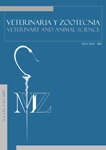Autores/as
Resumen
RESUMEN: Se realizaron dos experimentos para determinar los requerimientos nutricionales de proteína bruta (PB) para gallinas livianas y semipesadas, durante la primera fase de producción (19 a 29 semanas de edad); evaluar y establecer el efecto de la proteína sobre el desempeño de gallinas ponedoras en condiciones climáticas del bosque muy húmedo premontano (bmh-PM). En el primer experimento se utilizaron 300 aves Hy-Line W-36 y en el segundo experimento 200 aves Hy-Line Brown, distribuidas en un diseño experimental irrestrictamente al azar (DIA) con cinco tratamientos, cinco repeticiones y 12 aves Hy-Line W-36® y 8 aves Hy-Line Brown®, por unidad experimental. Las aves fueron alimentadas con una dieta básica de maíz y torta de soya, con 2800 kcal de EM/kg y cinco niveles de PB (14, 15, 16, 17 y 18%). No mostraron diferencias estadísticas (P>0,05) en las variables producción de huevo, conversión alimenticia, consumo de alimento, huevos por ave alojada y humedad de las heces, tanto en aves livianas como en semipesadas. Entretanto, la edad al pico de producción disminuyó con el incremento en el nivel de proteína en las aves livianas, mientras la ganancia de peso aumentó con los niveles crecientes de PB. Es posible alimentar aves livianas y semipesadas en condiciones ambientales del bosque muy húmedo premontano (bmhPM) con raciones entre 14% y 17% de PB para lograr una buena producción de huevo, siempre que se ofrezca a las aves la cantidad diaria de aminoácidos esenciales limitantes y se mantenga una ganancia de peso corporal adecuada
Palabras clave
Citas
Bonekamp, R.P.; Lemme, A.; Wijitten, P.J.; Sparla, J.K. Effects of amino acids on egg number and egg mass of Brown (heavy breed) and White (light breed) laying hens. Poultry Science, v.89, n.3, p.522- 529, 2010.
Farran, M.T.; Dakessian, P.B.; Darwish, AH. et al. Performance of broilers and production and egg quality parameters of laying hens fed 60% raw or treated common vetch (Vicia sativa) seeds. Poultry Science, v.80, n.2, p.203-208, 2001.
Fasuyi, A.O.; Dairo, F.A.S.; Olujimi, O.T. Protein supplementary quality of vegetable leaf meal (Amaranthus cruentus) in the diets of laying hens: Egg laying performance, egg quality and heamatological implications. Journal of Food, Agriculture & Environment, v.5, n.3-4, p.294-300, 2007.
Filho, J.J.; Vilar da Silva, J.H.; Lindolfo da Silva, E. et al. Methionine + cystine requirements of semi-heavy laying hens from the starter to peak of egg production. Revista rasileira de Zootecnia, v.35, n.3, p.1063-1069, 2006.
Fru-Niji, F.; Niess, E.; Pfeffer, E. Effect of graded replacement of soybean meal by faba beans (Vicia faba L.) or field peas (Pisum sativum L.) in rations for laying hens on egg production and quality. Journal of Poultry Science, v.44, n.1, p.34-41, 2007.
Hammershøj, M.; Steenfeldt, S. Effects of blue lupin (Lupinus angustifolius) in organic layer diets and supplementation with foraging material on egg production and some egg quality parameters. Poultry Science, v.84, n.5, p.723-733, 2005.
Harms, R.H.; Russell, G.B.; Sloan, D.R. Performance of four strains of commercial layers with major changes in dietary energy. The Journal of Applied Poultry Research, v.9, n.4, p.535-541, 2000.
Hy-Line Internacional, Variedad W-36 y Variedad Brown. Guía de manejo comercial. Manual. Estados Unidos, 2010. p.11-12-14-18.
Ibrahim, S.; Blair, R.; Jacob, J. Using reduced protein diets to minimize nitrogen excretion of layer. In: Department of Animal Science. Abstracts. University of BC, Vancouver, BC. V6T1Z4, 1992.
Keshavarz, K. The effect of different dietary protein levels in the rearing and laying periods on the performance of white leghorn chickens. Poultry Science, v.63, n.11, p.2229-2240, 1984.
Keshavarz, K.; Austic, RE. The use of low-protein, low-phosphorus, amino acid- and phytase-supplemented diets on laying hen performance and nitrogen and phosphorus excretion. Poultry Science, v.83, n.1, p.75-83, 2004.
Keshavarz, K.; Nakajima, S. The effect of dietary manipulations of energy, protein, and fat during the growing and laying periods on early egg weight and egg components. Poultry Science, v.74, n.1, p.50-61, 1995.
Lemme, A.; Rostagno, H.S.; Knox, A.; Petri, A. Responses of laying hens to graded levels of dietary methionine. 22nd World’s Poultry Conference, Istanbul, Turkey. (Abstr.) 2004.
Meluzzi, A.; Sirri, F.; Tallarico, N; Franchini, A. Nitrogen retention and performance of brown laying hens on diets with different protein content and constant concentrations of amino acids and energy. British Poultry Science, v.42, n.2, p.213-217, 2001.
North, M.O.; Bell, D.D. Manual de producción avícola. 3.ed. México: Editorial El Manual Moderno, 1993. 829p.
NRC. Nutrient Requirements of Poultry. 9th rev. ed. Washington, D.C.: Natl. Acad. Press, 1994. Pavan, A.C.; Móri, C.; Garcia, E.A., et al. Níveis de proteína bruta e de aminoácidos sulfurados totais sobre o desempenho, a qualidade dos ovos e a excreção de nitrogênio de poedeiras de ovos marrons. 568 níveis de proteína bruta e de aminoácidos sulfurados totais sobre o desempenho, a qualidade. R. Bras. Zootec, v.34, n.2, p.568-574, 2005.
Peebles, E.D.; Zumwalt, C.D.; Doyle, S.M. et al. Effect of dietary fat type and level on broiler breeder performance. Poult. Sci., v.79, n.5, p.629-639, 2000.
Robbins, K.R.; Saxton A.; Southern, L. Estimation of nutrient requirements using broken-line regression analysis. Journal of Animal Science, v.84, n.13, E-Suppl. E155–E165, 2006.
Rostagno, H.S.; Teixeira, A.L.F.; Donzele, J.L. et al. Tablas Brasileñas para Aves y Cerdos. Composición de Alimentos y Requerimientos Nutricionales. 2.ed. Brasil: Centro Editorial Universidad Federal de Vicosa - Departamento Zootecnia, 2005. 186p.
SAS Institute. SAS/STAT User’s Guide. Version 6. 5.ed. Cary, NC: SAS Inst. Inc., 2002.Sauer, N.; Emrich, K.; Piepho, H.P. et al. Meta-analysis of the relative efficiency of methionine-hydroxy-analogue-free-acid compared with dl-methionine in broilers using nonlinear mixed models. Poultry Science, v.87, n.10, p.2023-2031, 2008.
Sterling, K.G.; Costa, E.F.; Henry, M.H. et al. Responses of broiler chickens to cottonseedand soybean meal-based diets at several protein levels. Poultry Science, v.81, n.2, p.217-226, 2002.
Summers, J.D.; Leeson, S. Influence of diets varying in nutrient density on the development and reproductive performance of White Leghorn pullets. Poultry Science, v.72, n.8, p.1500-1509, 1993.

 PDF
PDF
 FLIP
FLIP










